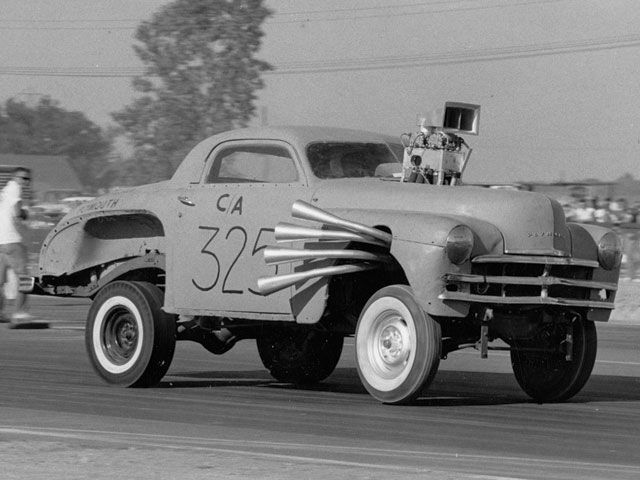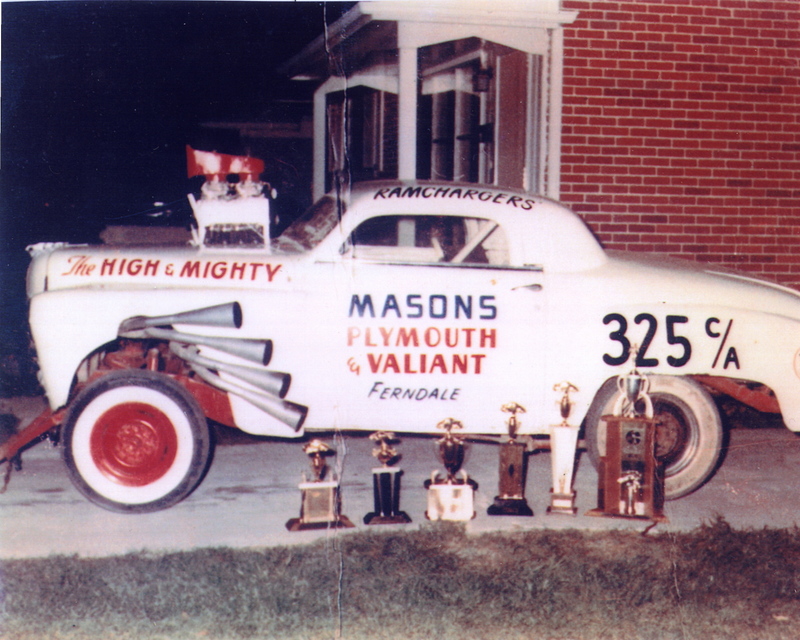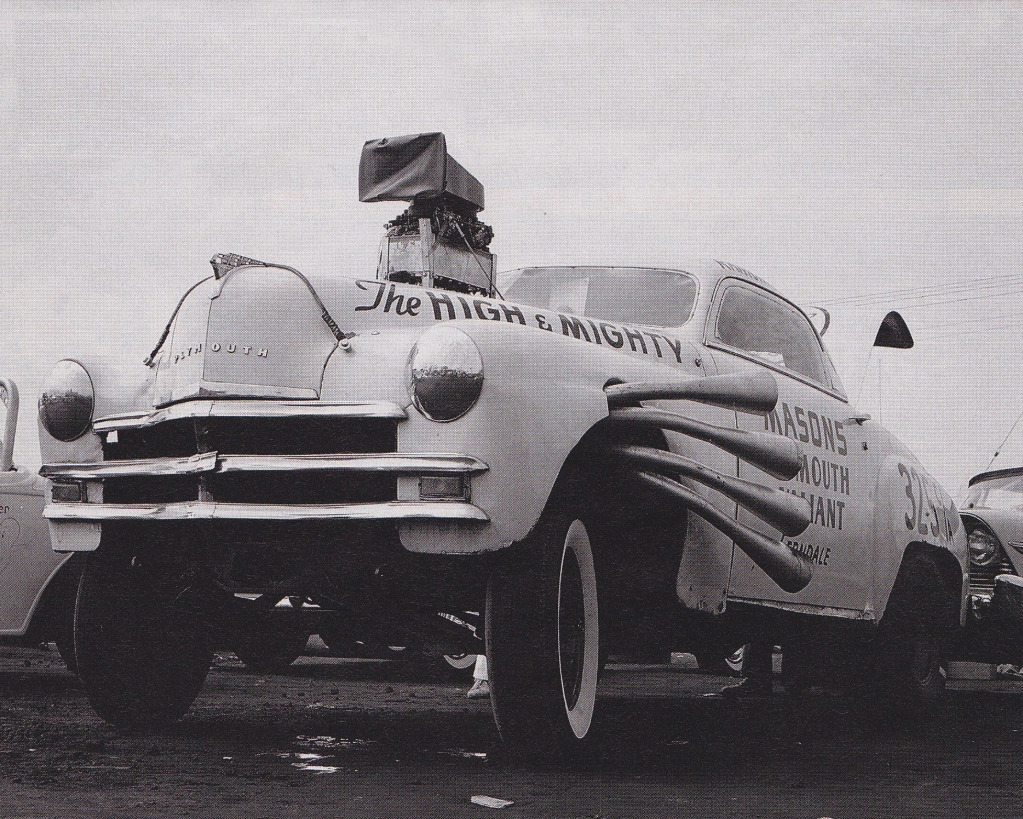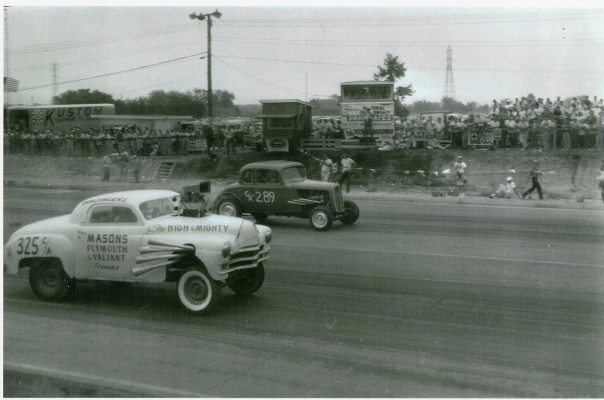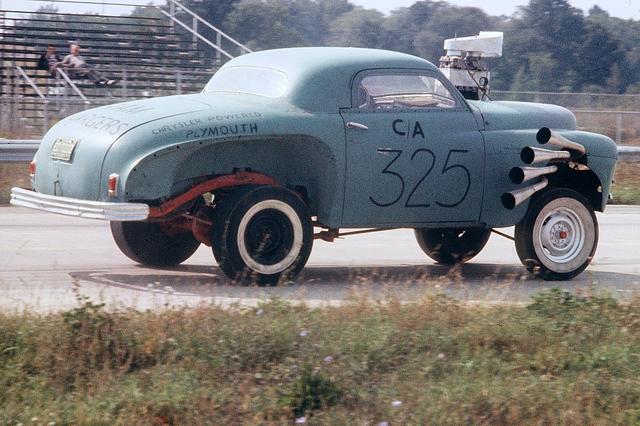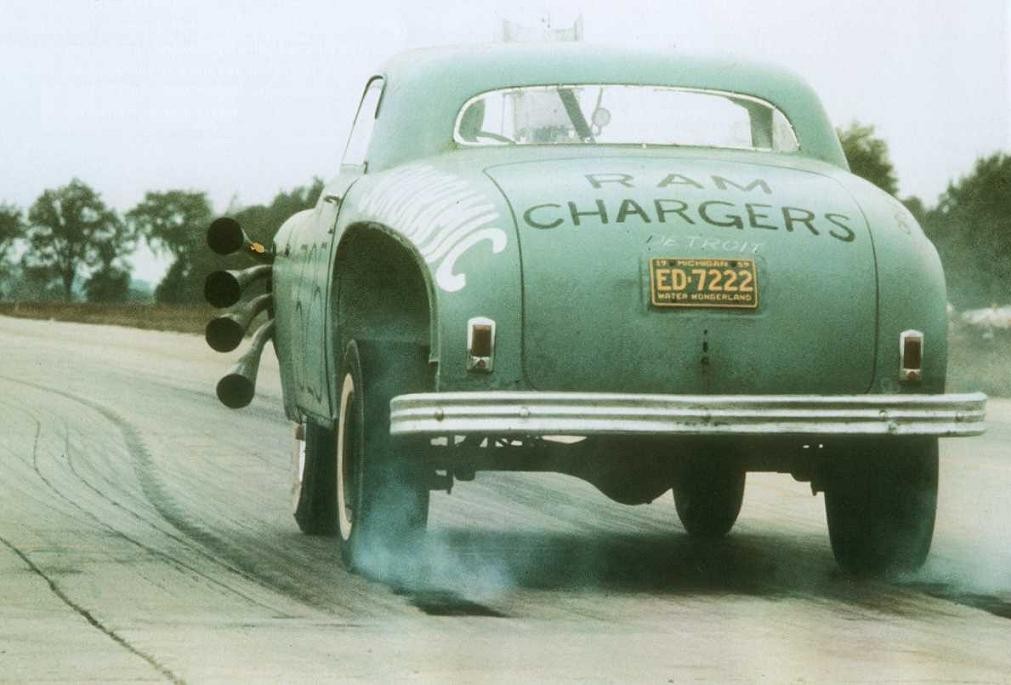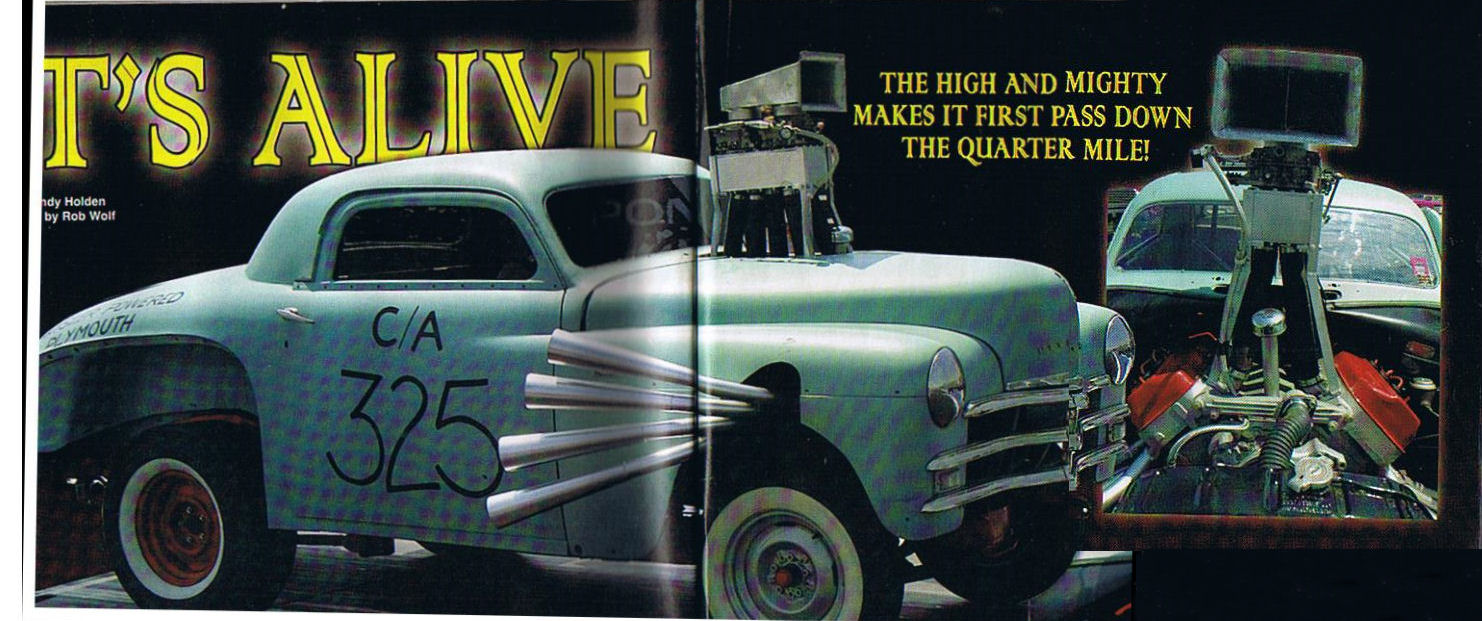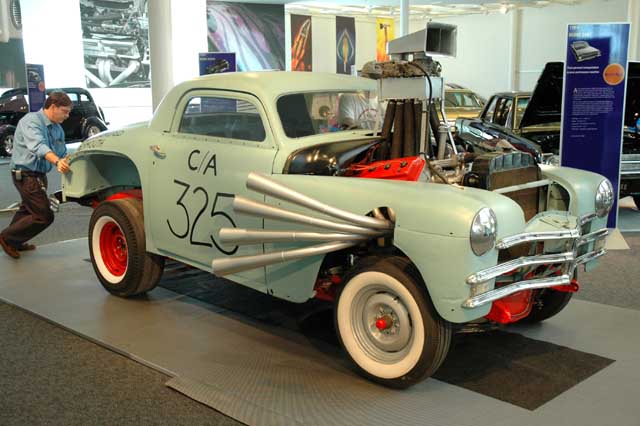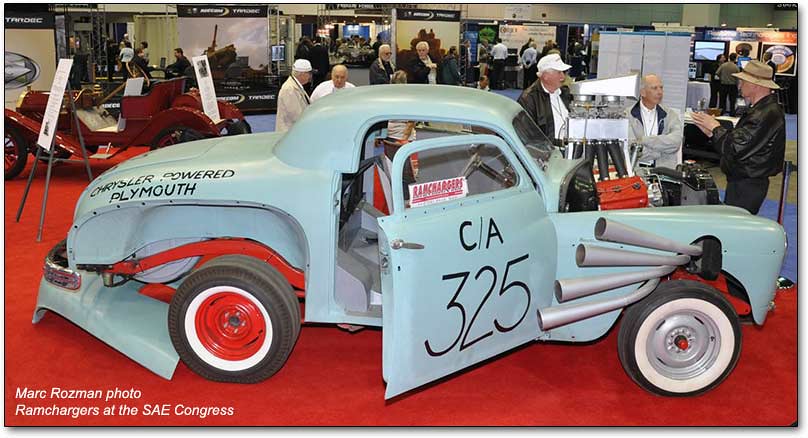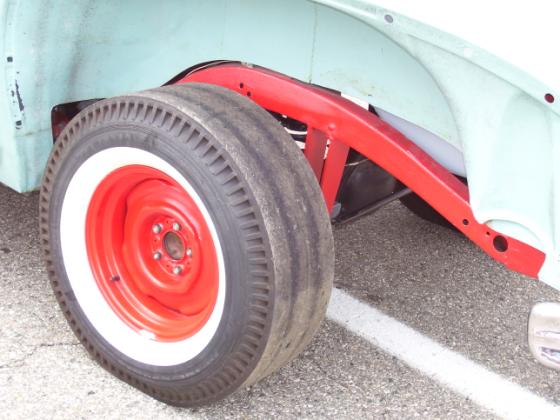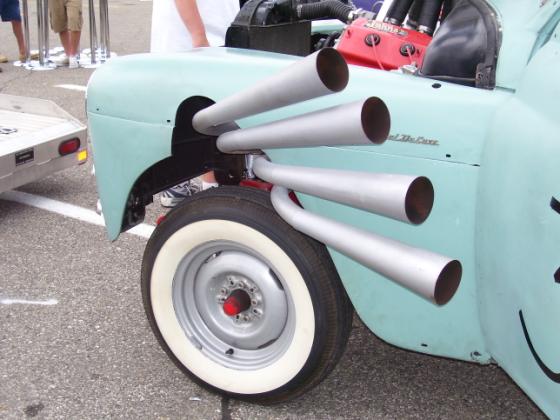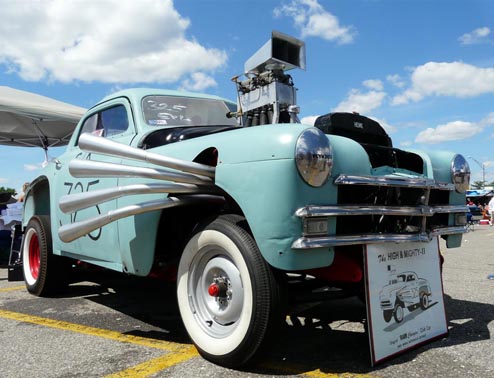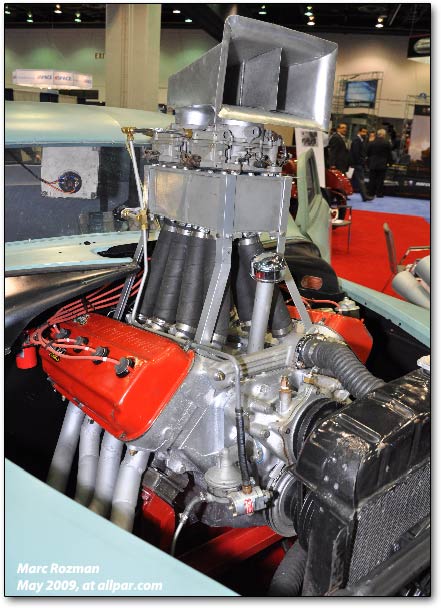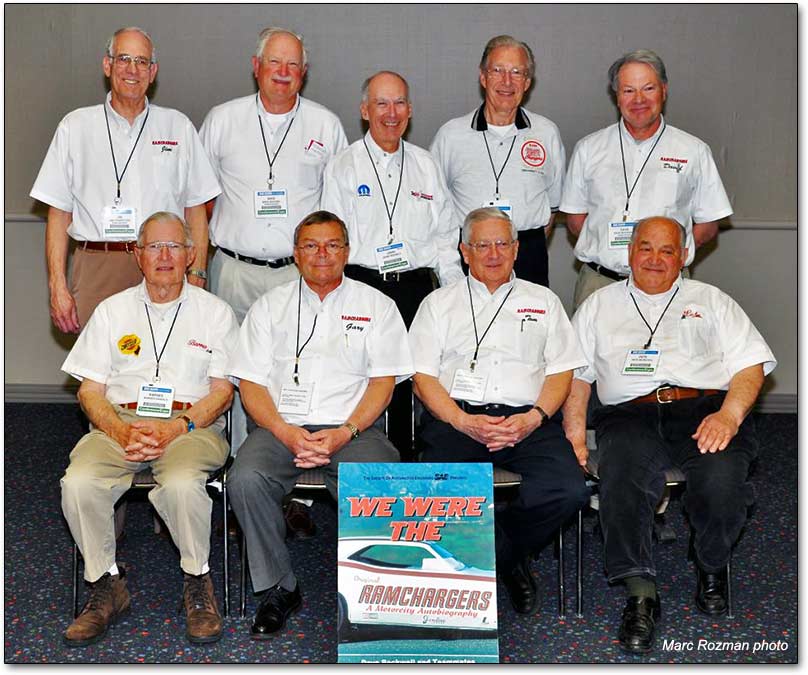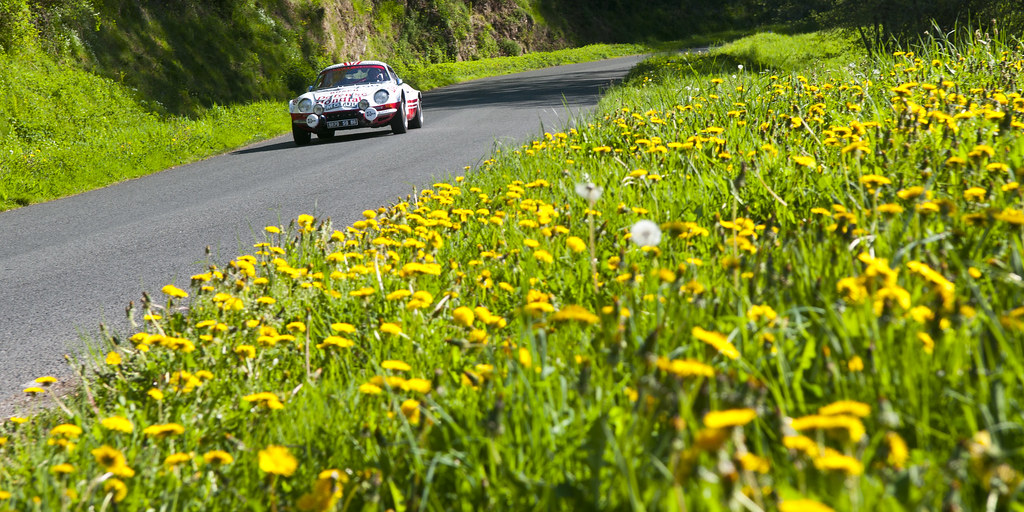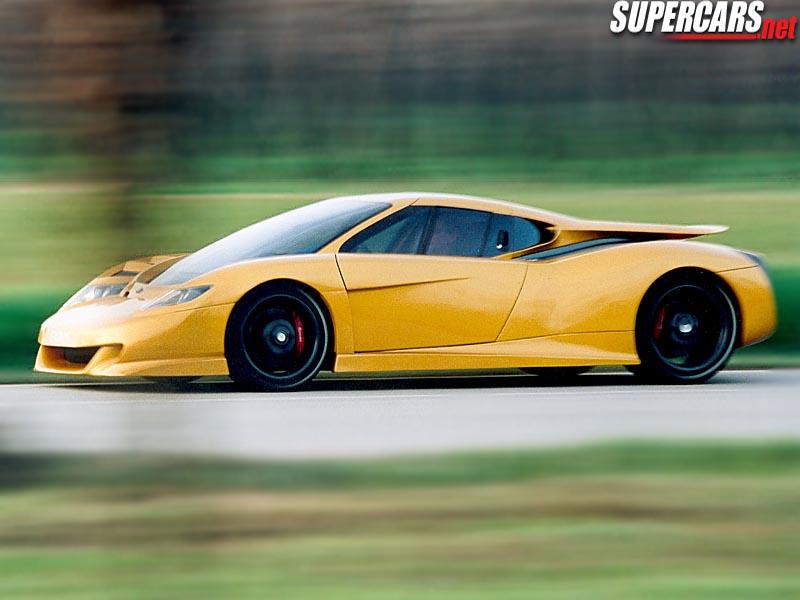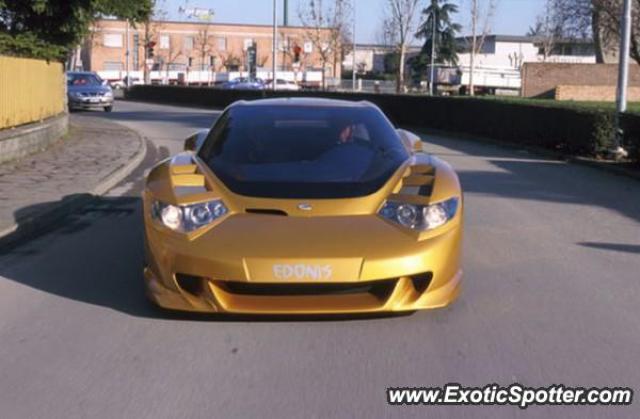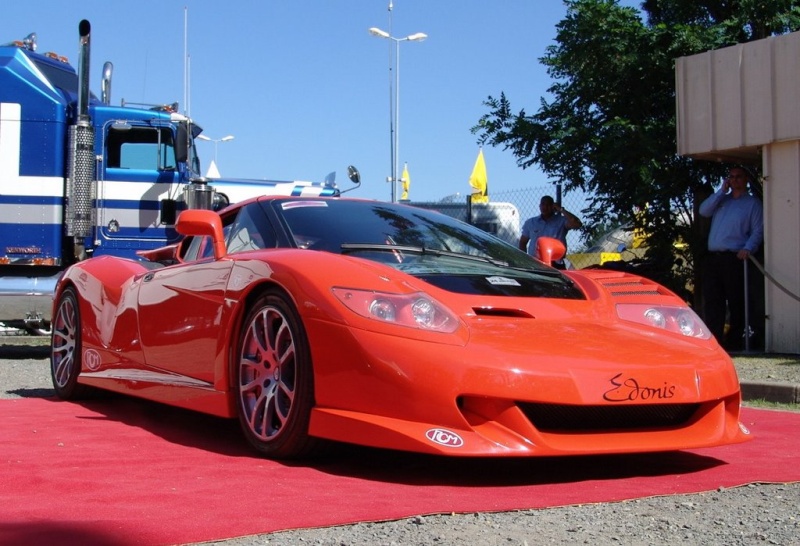29 July 2011
Drag Racing History - Ram Charger's High & Mighty
There is a reason that in the early '60s, suddenly every drag car sat like a frog on a hot rock, and here it is: the High and Mighty. A group of young Chrysler engineers who called themselves the Ram Chargers determined that raising the car's centre of mass would produce more forward bite. Everyone copied. The Ramchargers would become even more influential as the nucleus of Chrysler's all-conquering NASCAR, drag racing, and muscle car programmes throughout the '60s.
The "High & Mighty" was the first Ramchargers project. It ran in C/A and was powered by a 354ci hemi with 392ci heads. First outing was at the '59 Nationals, held, for the first time, at the Detroit Dragway, where it set best class speed for the meet. Texas' Billy Rassmussen won the class with his Dodge hemi-powered car. The Ramchargers chose C/A because, with the exception of Billy's car, Chevys dominated the class. The Ramchargers car went on to set and reset E.T. and speed records in the class.
Finally, the car was eliminated.
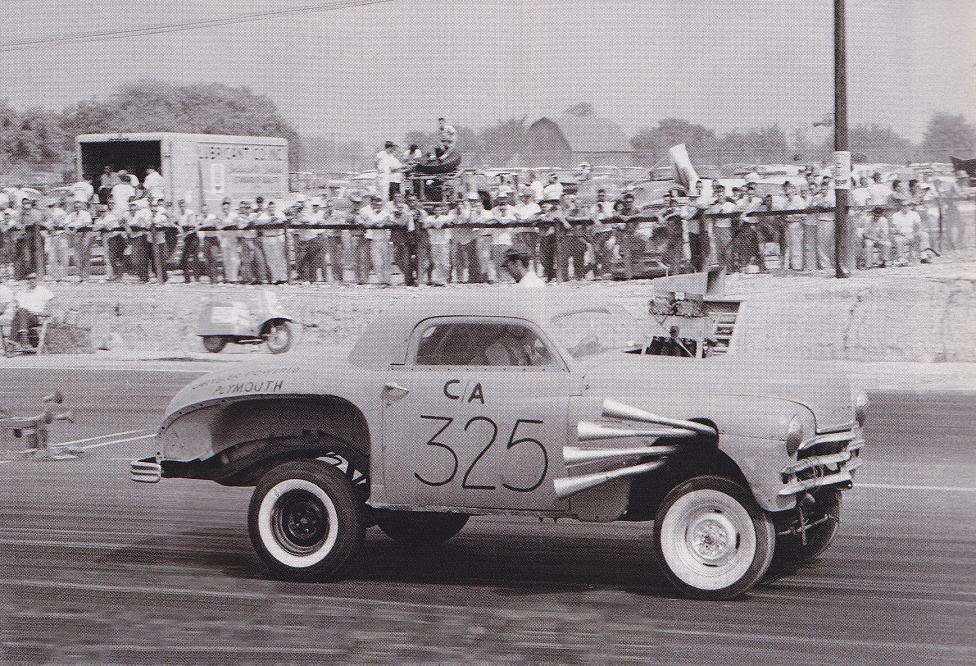 |
| At the '59 Nationals |
No, not by anything powered by a Chevy, but by a rule book. The NHRA introduced its crankshaft height rule and then changed the pounds per cubic inch from 8.6 to 8.0. With that heavy hemi engine, the first rule essentially made the car obsolete. It needed the high centre of gravity to be competitive with the Chevy powered deuce coupes off the line. (It was the first car to be deliberately raised for more effective weight transfer. The valve covers were right up against the underside of the hood.) The second rule change allowed the Chevy powered cars to recapture the E.T. and speed records. (This is not to say that a modern Chevy engine couldn't exceed the specific output of that hemi engine built back in the fifties. But, that's a sword that cuts both ways.)
The High & Mighty replica was built by members of the Chrysler Employees Motorsports Association (CEMA) in tribute to the Ramchargers’ accomplishments after it was determined that the original car had been scrapped. The car contains the original first tunnel ram intake manifold and tachometer hand marked with a “SHIFT! (dammit)” note with skull and crossbones at 5,500 RPM. The car is used for exhibition runs and to promote Chrysler and its products. It was built as it first appeared at the '59 Nationals, ugly green primer and all.
To my eyes, with this car you're just starting to see the first shoots of what will grow into Funny Cars. Bookmark this thread and compare this car with some of the cars to come.
We'll be seeing more 'Ramchargers' cars later in the series.
With thanks to all sources concerned for the info.
27 July 2011
This Pink Bug's No Lady
Another beetle on The 'Effect? Well, when they're as good as this, I'll post them 'til the cows come home. Roof chopped, banded wings, a 'built' 2.1 litre lump and painted a colour you'd normally find on a Nissan Micra in Essex. It plows it's own furrow, something the aircooled VW scene desperately needs more of.
Get the lowdown on this squat bug here.
Get the lowdown on this squat bug here.
 |
| Wiiide enough for ya? |
25 July 2011
B.Engineering Edonis - EB110 Redux
The Edonis. Never heard of it? Pull up a seat and let Uncle Amazo enlighten you.
Designed and built by B.Engineering in Modena, the fledgling company's first model drew heavily on the then just-defunct Bugatti EB110 and was the brainchild of a team of mainly ex-Bugatti engineers.
Designed and built by B.Engineering in Modena, the fledgling company's first model drew heavily on the then just-defunct Bugatti EB110 and was the brainchild of a team of mainly ex-Bugatti engineers.
Build to compete head to head with the Lamborghini Murcielargo, Ferrari 575M and Pagani, with their Mercedes-powered Zonda C12, the Edonis, the name being the Greek word for "pleasure", was projected for a total production run of 21 cars; one for each century. Each car was individually named after a famous inventor or artist from each of the 21 centuries.
The creative team for the Edonis were hugely experienced, to say the least. Led by Chairman Jean-Marc Borel (the 'B' in B.Engineeering ) and Managing Director Frederico Trombi, another Artoli Bugatti old boy who also worked for Ferrari. Project leader, Nicola Materazzi, has run programmes for Bugatti and Laverda, and, while at Ferrari headed the Testarossa, 288 GTO and Evoluzione, and F40 developments as well as running the F1 R&D team. Further back in his career he worked on the Lancia Stratos. The project saw input from designers who had worked for Lamborghini, Bugatti, Maserati, Lotus, Ferrari, Cagiva, Laverda, Aerospatiale and Michelin, as well as in GT racing. All based in a unit which is part of the mothballed Bugatti plant that knocked out the EB110 in the first place.
The car really was a collaborative effort when you consider the technical partners who Borel worked with. As with the EB110, Aerospatiale Matra Group designed the carbonfibre chassis and testing was carried out with Michelin, who specially tweaked their Pax System tyres for the car. Local specialist companies around Modena manufactured the engine, gearbox and transmission. The carbonfibre chassis is covered in hand beaten aluminium, Modena being one of the few locations where this dying craft is still practiced, while final assembly was done back at B.Engineering HQ.
The engine is the centrepiece of any supercar and the Edonis was no exception. To recap, the EB110 had a 60 degree V12 engine; its configuration was very Italian, but the ancillaries are what made the 3.5 litre V12 unusual. The dual overhead camshafts operated five valves per cylinder, a setup unusual for a V12 and only seen in the Ferrari F1 racers of the day. Four IHI Turbochargers were mated to the high revving engine, giving the EB 110 an then-unprecedented output of over 550 bhp.
For the Edonis, the engine has had its displacement increased to 3760 cc. Two larger IHI turbos have replaced the original four small ones. Engine power was boosted from 603 bhp and 479 lb/ft of torque (of the EB110SS) to 671 bhp at 8000 rpm and 542 lb/ft.
In addition, the 4WD triple-differential drivetrain from the original Bugatti has been replaced with a much simpler and lighter RWD transaxle, thus saving approximately 70 kg from total weight. These power figures give the 1500 kg Edonis a power-to-weight ratio of 480 bhp/ton. In addition, the engine's specific power output was an unprecedented 181 bhp/litre. The company claimed a maximum speed of 227 mph, while the 0-60 time was only 3.9 seconds.
For the Edonis, the engine has had its displacement increased to 3760 cc. Two larger IHI turbos have replaced the original four small ones. Engine power was boosted from 603 bhp and 479 lb/ft of torque (of the EB110SS) to 671 bhp at 8000 rpm and 542 lb/ft.
In addition, the 4WD triple-differential drivetrain from the original Bugatti has been replaced with a much simpler and lighter RWD transaxle, thus saving approximately 70 kg from total weight. These power figures give the 1500 kg Edonis a power-to-weight ratio of 480 bhp/ton. In addition, the engine's specific power output was an unprecedented 181 bhp/litre. The company claimed a maximum speed of 227 mph, while the 0-60 time was only 3.9 seconds.
The all carbonfibre chassis, was again drawn from the EB110, but were not reused surplus Bugatti shells as has been rumoured; Dauer Sportwagen (they of Le Mans Porsche 962 fame) bought the unused EB110 chassis from the creditors of Bugatti Automobili S.p.A., when they purchased that company's assets to make their own updated version of the EB110 (feature to come).
It features double wishbone suspension all round, ABS, and a locking differential. A large rear diffuser keeps the car on the ground, while inside the Edonis has a full airbag protection system.
The Edonis sits on the ground courtesy of Michelin Pax-system development tyres, 245/650 ZR480 on the front and 335/670 ZR 500 on the rear. This equates in old money to marginally over 18in wheels at the front and a whopping-for-the-time 20in at the rear.
 |
| Why so sad? |
The shape was drawn by Materazzi along with ex-Bertone designer, Marc Deschamps. They were looking for an individual styling signature while keeping away from the 'GT-racer;' style that many startup supercar companies graviate to. Many hours were spent in the Dallara windtunnel working on maximising downforce at high speed.
While it has a name that sounds like Adonis, the Edonis has a face only it's mother could love. Granted its no A10 Warthog, but ravishing beauty it ain't. This was of course partly a legacy of it EB110 origins, but one still feels that the Nazionalis they were smoking in the styling dept that day were a wee bit stronger than usual.
B Engineering planned to build only 21 vehicles for €760,000, (an eye-watering £500,000 or so in the ‘90s) but it is unlikely they've reached that goal yet.
 |
| The interior; not as cohesive as the well finished EB110 original, but more in keeping with the wacky exterior |
Did any make it out? Well, from what I can gather from pictures yes, a few did. The one below was apparently snapped in London a while back:
whether its a road test car or a customer's own is not known; my bet is a magazine had it on test from the factory, due to the lack of a front numberplate. I doubt it's in London as unless it's a one-way street he's driving on the wrong side of the road.
B.Enginnering still exists, seemingly working with Dauer as a service point for Dauer and their version of the EB110.
whether its a road test car or a customer's own is not known; my bet is a magazine had it on test from the factory, due to the lack of a front numberplate. I doubt it's in London as unless it's a one-way street he's driving on the wrong side of the road.
B.Enginnering still exists, seemingly working with Dauer as a service point for Dauer and their version of the EB110.
 |
| Just in case you've lived under a rock to escape Take That, here's the original car the Edonis is based on, the Bugatti EB110 (this one's a Supersport). Oh, and Take That are still around, sorry. |
Subscribe to:
Posts (Atom)


